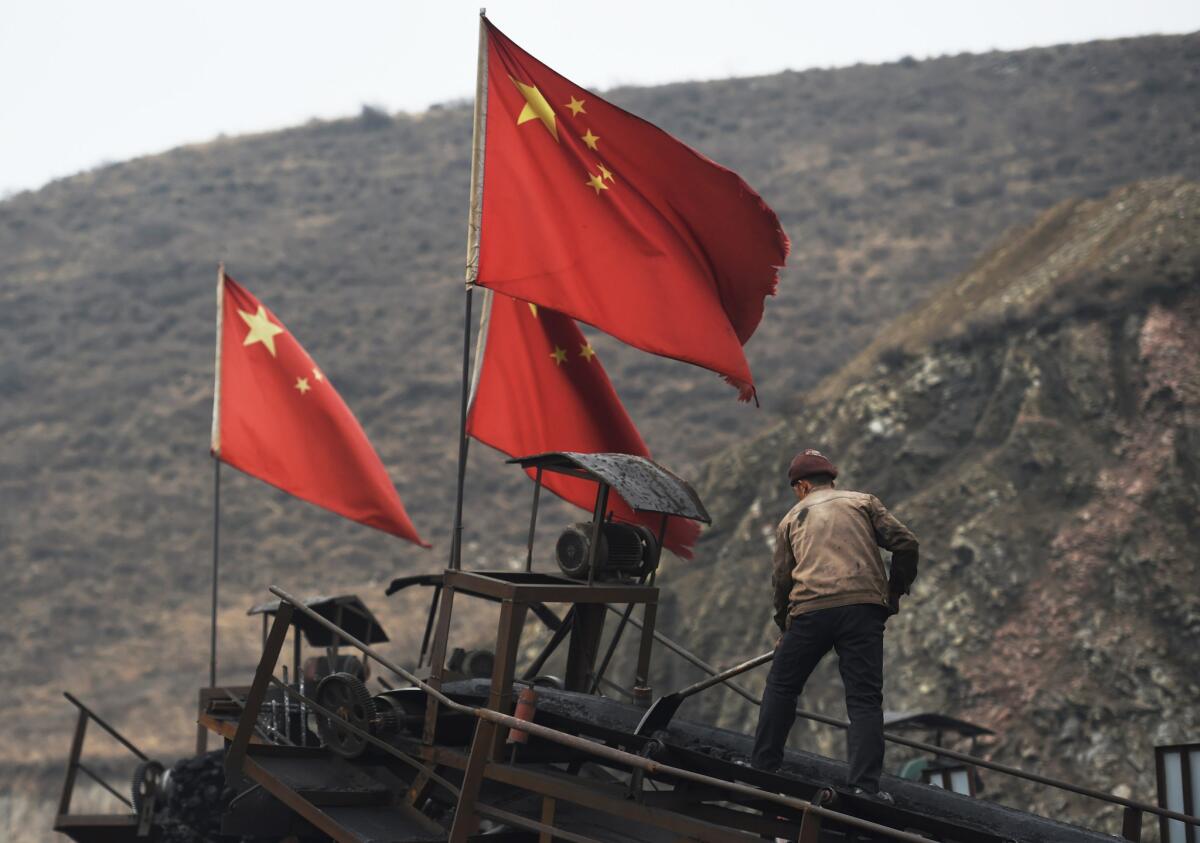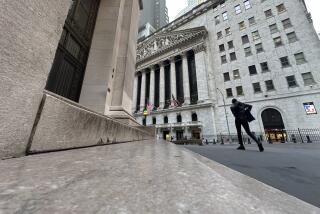Five economic fears behind the Chinese stock slide that shook world markets

Chinese flags fly as a worker clears a conveyer belt near a coal mine at Datong, in China’s northern Shanxi province, on Nov. 20, 2015.
- Share via
Reporting From Washington — For the second time in less than six months, concerns about China’s rocky transition from an export-fueled industrial nation to a more mature developed economy have rattled global financial markets.
The trouble began Monday when a private report showed a slowdown in China’s manufacturing sector had worsened last month.
Fears that the nation’s economic growth was slowing more than official figures indicated helped trigger a 7% drop in the Shanghai composite index.
See more of our top stories on Facebook >>
That caused markets to tumble in Europe and the U.S.
The Dow Jones industrial average plunged more than 450 points before recovering some of its losses in one of the worst ever year-opening sessions.
Markets settled down Tuesday, starting in China, where the nation’s central bank pumped $20 billion into the financial system to help calm investors.
But the spasm, like a similar one last summer, highlighted worries about China’s economy.
Here are five key concerns:
Growth is slowing
The world is struggling to adjust to a new normal in which China’s once red-hot growth has cooled -- partially according to the plans of Beijing’s leaders to shift economic power from state planners to consumers but also because of massive over-investment in real estate and related sectors.
“China grew faster and for longer than any other country in recorded history. They were already in uncharted territory,” said Nicholas Lardy, a senior fellow at the Peterson Institute for International Economics. “Some slowdown was inevitable.”
A nation that saw double-digit economic growth might not have hit its lower 7% target for 2015. President Xi Jinping said Beijing was lowering the goal going forward, aiming for 6.5% annual growth from 2016 to 2020.
The deceleration of what is now the world’s second-largest economy could have ramifications for the U.S. and other nations.
China is a key market and a slowdown could cause consumers and companies there to buy fewer foreign goods.
Growth might be slowing more than Beijing says
To put China’s growth in context, the U.S. economy only grew about 2% last year. So 6.5% growth still would be strong, especially considering that China’s economy is much larger than it was several years ago.
“It’s going to deliver and is delivering better growth than most markets around the globe,” said John Frisbie, president of the U.S.-China Business Council in Washington.
But there is some skepticism about the accuracy of China’s official government data, which could be understating the economy’s actual growth.
On Monday, investors seized on a downbeat manufacturing purchasing managers report from Caixin Insight Group as an indication that the sector might be slowing faster than government statistics have shown.
“People don’t believe the official data ... and that’s where I think a lot of the [stock market] volatility comes from,” said Derek Scissors, a China economy expert at the American Enterprise Institute think tank.
Complicating the issue further, there is much more government data on industrial production than on the services sector. That can skew the view of the overall economy.
“It’s a legacy of the old state planning model, which was very focused on agriculture and industry and did not pay much attention to services,” said David Loevinger, an Asia strategist at Los Angeles investment firm TCW Group.
Rising debt and other headwinds
China’s economy couldn’t keep up its double-digit annual growth rate in part because it was driven by a sharp increase in debt and aggressive expansion of its industrial and real-estate sectors as the country grew, experts said.
“The Chinese have a ton of sectors that should contract, anything to do with building materials, a lot of transport sectors,” Scissors said. “Those industries are going to need to shrink.”
To help finance the expansions, China dramatically increased its borrowing.
The nation’s overall debt quadrupled to $28 trillion from 2007 to early 2014, according to a report from the McKinsey Global Institute.
Though the debt is manageable, the ratio of debt to economic output is larger than that of the U.S. or Germany, the report said. That raises alarms.
“Three developments are potentially worrisome: half of all loans are linked, directly or indirectly, to China’s overheated real-estate market; unregulated shadow banking accounts for nearly half of new lending; and the debt of many local governments is probably unsustainable,” the report said.
On top of that, China’s population is aging rapidly.
That’s one reason why the Chinese Communist Party announced in October that it was ending its one-child policy.
All of that adds up to obstacles for the Chinese economy.
“You have these long-term growth tailwinds turning into headwinds,” Loevinger said.
Beijing’s commitment to reform
There’s broad agreement that China’s economy needs to evolve to be less dependent on exports and more on internal consumption. That’s the path to a truly developed economy.
“Significant policy adjustments are required in order for China’s growth to be sustainable,” the World Bank said in assessing the nation’s economy last year. “Experience shows that transitioning from middle-income to high-income status can be more difficult than moving up from low to middle-income.”
The growing pains were evident last summer, when Beijing’s leaders began loosening their grip on the Chinese currency. The value of the yuan tumbled, triggering financial market turmoil in China and around the world.
China appears to be moving to a more market-based monetary and exchange-rate policy from one with tight government control, Loevinger said.
“They know where they want to go but they’re not there yet,” he said.
The rough ride has been compounded by skepticism that China’s leaders are committed to wholesale change.
Scissors worries that China will try to boost its economy by turning to the old government-control tactic of devaluing its currency. That would make its goods cheaper for foreign buyers.
“If they move toward a healthier economy and allow more competition around the world, that’s good for the world,” he said. “If they try to devalue their currency and export their problem, that’s not good for the world.”
Tight control of market access
U.S. businesses operating in China are less concerned about a slowing economy there and more worried about gaining better access to one that continues to grow, Frisbie said.
“They’re watching that slowdown to make sure it’s managed properly and it’s certainly impacting the top-line of a lot of those companies,” he said.
“But companies also feel like, given the size of China’s economy, that it will continue to deliver growth, and they’re equally concerned about being able to access that growth,” Frisbie said.
He pointed to Hollywood movie studios. China is the second-largest movie market and box-office receipts jumped nearly 50% last year.
“There’s strong consumer demand there. U.S. companies did well, but there are restrictions on the number of films,” Frisbie said.
China allowed only 58 foreign films to be shown there last year. Just 34 of those were allowed on a revenue-sharing basis, which allows the studio to take up to 25% of box-office receipts.
Such market-access limits are frustrating to foreign companies.
The U.S.-China Business Council has been pushing for completion of negotiations on a bilateral investment treaty between the two nations to help remove some of the restrictions on foreign investment, Frisbie said.
Follow @JimPuzzanghera on Twitter
MORE FROM WORLD
‘Mr. Six’ crosses $100 million, tops China box office
Mexican marijuana farmers see profits tumble as U.S. loosens laws
Who was Sheik Nimr al-Nimr? A look at the man whose execution rocked the Mideast
More to Read
Inside the business of entertainment
The Wide Shot brings you news, analysis and insights on everything from streaming wars to production — and what it all means for the future.
You may occasionally receive promotional content from the Los Angeles Times.











